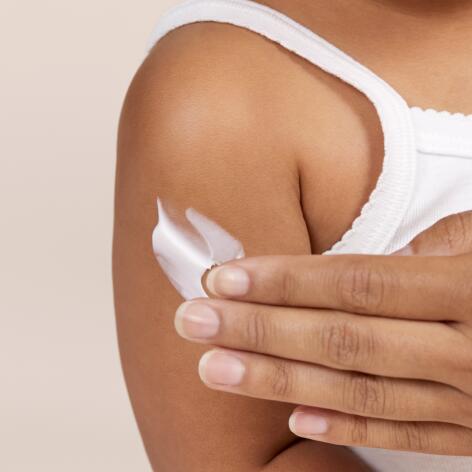Understanding and taking care of dry skin
I have dry skin!” Who hasn't said that? But are you sure it's really dry skin? Because dry to very dry skin is a very specific type of skin. So how can we identify it and take better care of it? We’ll tell you everything.

What is dry skin?
Dry skin isn't just a little tightness after showering. Dry skin is in fact a skin type in its own right. Like combination or oily skin. It is therefore a permanent state.
Due to a lack of lipids. Sebaceous glands do not secrete enough sebum, which is essential in maintaining an efficient barrier of the skin. Dry skin should not be confused with dehydrated skin, which lacks water.
How to identify dry skin?
Not sure if your skin is really dry? Some clinical signs can help you establish the right “diagnosis”:
- Does your skin feel tight and tingly all over your face?
- Does this discomfort throughout the day?
- Does your skin never shine?
- Does your makeup last all day?
- Do dry spots and redness sometimes appear?
- Do you get lasting relief from an oily cream?
If you have all these questions the answer is “Yes”, chances are you’re dealing with dry skin.
Everything you need to know about the tell-tale signs of dry skin

Whenever winter arrives my skin is dryer. I have to change my routine and embrace richer creams so I don’t feel taut.
What causes dry skin?
Dry skin is skin that cannot adequately produce its own lipids. This is linked to a dysfunction of the sebaceous glands. But why this malfunction?
- Dry skin can be pathological. Hypothyroidia, psoriasis, contact eczema, etc. To ensure the best care for this dryness, you need to perform a precise diagnosis. Your dermatologist will therefore be able to advise you about a suitable treatment.
- It can also be hereditary. Some people naturally produce less lipids.
- The common dry skin. This is the most common. It may be linked to age, unsuitable and overly harsh cosmetic products, to climatic conditions, etc.
- Finally, certain medicines may also be involved. For example, some acne treatment such as isotretinoin, a molecule used to treat acne. However, in this case, the skin can only dry out during treatment period.
Dry skin: skin that needs nourishment
Dehydrated skin needs to be thirsty then dry skin and it needs to be nourished.
Given that it doesn’t produce enough sebum, you must give it an oil-free substance to keep it in good condition.
The lipids that you will release will act like a cement to reinforce the cells together. Just like a brick wall: if the latter no longer has the necessary cement it will finish by framing. Skin is the same.
By nourishing your skin, you’ll restore its protective barrier, the hydrolipidic film. That will also prevent water from evaporating and allow your skin to stay beautiful and hydrated over time.
Nourishing your skin also helps to strengthen the skin's barrier, fight against external aggressors and protect against dehydration.
All of our tips to nourish your skin


Dry skin: daily care
“Dry skin” means that you will have to adapt by focusing on dedicated skin care, but also adopt habits to repeat every day. Because if dryness results from internal factors (against which is difficult to combat), it is also accentuated by external elements.
So why is it better to avoid hot showers and baths? What cosmetics and skin care should you use every day? And what can be avoided? Does dry skin prevent use of exfoliators? How do you specifically nourish your hands or legs? Should the hygiene ritual be the same in the winter and summer? Does diet play a part?
Follow the guide to find answers to these questions... and many more.
Our tips for taking care of dry skin
FRIENDLY (AND EXPERT) ADVICE
Dry or dry to the touch, applying a moisturizing or replenishing balm will be your best friend. This will restore and nourish your skin weakened by external aggressions. Using a balm, with circular massages, concentrating on rough or dry areas, is an essential daily step to restore the skins comfort.
WE ANSWER YOUR QUESTIONS
To sort the true from the false: that's what we're here for.
FALSE. Dry skin is due to disruption of the sebaceous glands. So it’s absolutely possible to have healthy, but naturally dry skin. On the other hand, proper hygiene products can accentuate dryness, but in this case, there is a clean word of hygiene.
TRUE. Cold exacerbates dry skin. In winter, the body controls the vessels on the surface of the skin to shrink. This is called vasoconstriction. The purpose is to retain heat at the level of the vital organs. To the detriment of the epidermis. If you add to this a "hot-cold" alternation between overheated interiors and exteriors, you have all the elements to dry out the skin.
TRUE. The reason is simple: Because it’s not protected by clothing like the rest of the body, the skin of the face is at the first logs in relation to external aggressors: heat, cold, pollution. Not to forget that the skin on the face, thinner, is also more fragile. Note that the hands are also concerned.
Our solutions for dry skin
Eau Thermale Avène skincare products designed to make you feel better about your skin
Cold Cream: “It’s perfect for my skin and my children’s skin. It features a creamy texture and a delicate fragrance, I really love it!"
MORE
NEWSLETTER
We're always here for your skin!
All our tips on how to take care of your skin every day.

Which skin care routine should you adopt?
Identify what it really needs with the help of our experts and discover the most suitable skin care routine for you.



